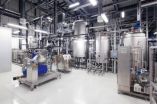(Press-News.org) A new study by an international team of scientists, including Dr Jan Zalasiewicz and Professor Mark Williams of the University of Leicester's Department of Geology, suggests that the fossil impact humans have made on the planet is vast and unprecedented in nature – and that there's been nothing remotely like it since the Earth formed, over four and half billion years ago.
The study, entitled 'The technofossil record of humans' and published by SAGE in The Anthropocene Review, argues that, like dinosaurs, who left their bones and footprints behind for future generations to discover, humans will also leave a footprint behind – one made up of material goods unique to mankind that are so different from anything else produced by animals in the history of the Earth that they deserve their own name: technofossils.
Dr Zalasiewicz said: "Palaeontologists call preserved animal-made structures trace fossils. Most animal species make only one – or at most a very few – different types of trace. For example, dinosaurs made footprints and worms leave burrows. Just one species, though, Homo sapiens, now manufactures literally millions of different types of traces that range from nano-scale to city-sized.
"Whereas trace fossils such as animal burrows changed their pattern with geological slowness, over millions of years, as the organisms that produced them evolved, the things that humans manufacture now evolve with lightning speed, as our factories bring new goods to the market each year – and make old ones obsolete. Many of the cast-off objects that now litter the landscape will become buried in sediment – and will be well on the way to becoming technofossils."
The study suggests that humanity's equivalent of the dinosaur's footprint will be in the form of a wide array of technofossils such as motorways, cities, airports, toothbrushes, ballpoint pens and mobile phones – everything that we build or manufacture.
Professor Mark Williams added: "Millions of years from now, long after humans have gone, technofossils will be the defining imprint on the strata of the human epoch that people increasingly call the Anthropocene. If any palaeontologists were to appear on – or visit – the Earth in the far geological future, they will think the technofossil layer more weird and wonderful, by far, than dinosaur bones. It's something to think about when you next park the wheelie bin at the end of the drive."
INFORMATION:
The Anthropocene Review is a trans-disciplinary journal issued three times per year, bringing together peer-reviewed articles on all aspects of research pertaining to the Anthropocene. Its overall aim is to communicate clearly and across a wide range of disciplines and interests, the causes, history, nature and implications of a world in which human activities are integral to the functioning of the Earth System.
The study, 'The technofossil record of humans', can be found here: http://anr.sagepub.com/content/early/2014/01/06/2053019613514953.full.pdf
The study will appear in the April 2014 print issue of The Anthropocene Review.
Technofossils -- an unprecedented legacy left behind by humans
New international study by academics from the University of Leicester highlights unique nature of fossil footprint left behind by mankind
2014-03-25
ELSE PRESS RELEASES FROM THIS DATE:
Managing renewables intelligently
2014-03-25
"Wind, solar and biogas are all energy sources with their own strengths and weaknesses. And it's by combining the strengths of each in a smart way that we'll be able to guarantee Germany's energy supply into the future," says Dr. Kurt Rohrig, deputy director of the Fraunhofer Institute for Wind Energy and Energy System Technology IWES in Kassel. But what happens when, instead of a big power plant, you have a host of individual small energy producers feeding in energy to the grid at varying times? Is reliable operation of the grid still technically feasible? In the "Combined ...
Sugar, not oil
2014-03-25
Plastic, gasoline, rubber – very many items we use every day are based on oil. But this raw material is becoming increasingly scarcer. Step by step researchers are therefore investigating possibilities for using renewable raw materials to replace oil. One well-known example of this is biodiesel, which comes not from oil sources, but from fields of yellow-flowering rape. In future it is planned to produce another substance from plants, namely isobutene, a basic chemical used in the chemical industry to produce fuels, solvents, elastomers or even antiknock agents in fuel. ...
Plasma tool for destroying cancer cells
2014-03-25
Plasma medicine is a new and rapidly developing area of medical technology. Specifically, understanding the interaction of so-called atmospheric pressure plasma jets with biological tissues could help to use them in medical practice. Under the supervision of Sylwia Ptasinska from the University of Notre Dame, in Indiana, USA, Xu Han and colleagues conducted a quantitative and qualitative study of the different types of DNA damage induced by atmospheric pressure plasma exposure, the paper is published in EPJ D as part of a special issue on nanoscale insights into Ion Beam ...
Neck ribs in woolly mammoths provide clues about their decline and eventual extinction
2014-03-25
Researchers recently noticed that the remains of woolly mammoths from the North Sea often possess a 'cervical' (neck) rib—in fact, 10 times more frequently than in modern elephants (33.3% versus 3.3%). In modern animals, these cervical ribs are often associated with inbreeding and adverse environmental conditions during pregnancy. If the same factors were behind the anomalies in mammoths, this reproductive stress could have further pushed declining mammoth populations towards ultimate extinction.
Mammals, even the long-necked giraffes and the short-necked dolphins, almost ...
Famous paintings help study the Earth's past atmosphere
2014-03-25
A team of Greek and German researchers has shown that the colours of sunsets painted by famous artists can be used to estimate pollution levels in the Earth's past atmosphere. In particular, the paintings reveal that ash and gas released during major volcanic eruptions scatter the different colours of sunlight, making sunsets appear more red. The results are published today in Atmospheric Chemistry and Physics, an open access journal of the European Geosciences Union (EGU).
When the Tambora volcano in Indonesia erupted in 1815, painters in Europe could see the colours ...
Risk of alcohol-related cancer lowers the intention for binge drinking in college students
2014-03-25
Washington, DC (March 21, 2014) – Binge drinking for college students has proven to be a huge problem at many universities. The risk of DUI or even death makes it a public health concern that students and administrators need to face. A recent study by researchers at the University at Buffalo, State University of New York, found that college students exposed to the risk messages of alcohol-related cancer had lower intent to engage in binge drinking.
Cindy Yixin Chen and Z. Janet Yang of the University at Buffalo, State University of New York will present their study at ...
Dialing is the most distracting activity for drivers young and old alike
2014-03-25
Dialing is the most distracting activity for drivers young and old alike
Article provided by Fahrendorf, Viloria, Oliphant & Oster L.L.P.
Visit us at http://www.renonvlaw.com
In recent years, there have been numerous studies about the dangers of using cellphones while driving. In many of them, the research has assumed that the most distracting aspect of using a cellphone is talking. However, a new study has found that this is not the case.
The study, recently published in the New England Journal of Medicine, focused on a sample of 42 young drivers that had ...
Product liability: defending against claims of unsafe goods
2014-03-25
Product liability: defending against claims of unsafe goods
Article provided by Adler, Cohen, Harvey, Wakeman and Guekguezian, L.L.P.
Visit us at http://www.adlercohen.com
In our modern lives we are all dependent on manufactured products and rely on responsible, reputable manufacturers to keep those goods safe for our use. Because some companies have not historically lived up to their duties to keep the public safe from dangerous or defective products, laws and government agencies play a big role in setting safety standards, managing recalls and allowing individuals ...
The impact of divorce on business ownership
2014-03-25
The impact of divorce on business ownership
Article provided by Anthony C. Williams & Associates, PC
Visit us at http://www.anthonywilliamslaw.com
Many married couples own and operate small businesses together. Both spouses perform essential functions to ensure that the business is able to maximize its profits. The couple may spend a great deal of their time and money trying to keep the company running as efficiently as possible.
When one of these spouses decides to get a divorce, the entire process can quickly become very complex. The parties may not have ...
Missouri breathalyzer results may not be considered valid
2014-03-25
Missouri breathalyzer results may not be considered valid
Article provided by Featherston Law Firm
Visit us at http://www.mocriminallawattorney.com
When law enforcement officers use breathalyzer tests to determine whether a motorist is driving under the influence of alcohol, they are required to first test the breathalyzer to ensure it produces accurate results.
The guidelines for testing breathalyzers in Missouri are established by the Missouri Department of Health and Senior Services. In late November 2012, the regulations governing the testing of breathalyzers ...
LAST 30 PRESS RELEASES:
Music: Popular song lyrics have become more negative since 1973
Marine ecology: Killer whales tail dolphins to hunt salmon
ADHD prescriptions on the rise, study finds
How to build a genome
Sharp rise in ADHD stimulant prescriptions in Ontario, research finds
Trends and prevalence of the metabolic syndrome among US adults
Population-level trends in ADHD medication prescribing
Missing piece of myelin disturbs the brain’s rhythm
Insilico Medicine and Taigen achieves license agreement to develop and commercialize AI-driven PHD inhibitor for anemia of Chronic Kidney Disease (CKD)
Exploring dominant endophytic Pleosporales in grasses: New taxonomic insights in the suborder Massarineae
Comparative transcriptomic analysis of human maxillary and mandibular tooth germs reveals discrepancies in gene expression patterns
Scientists detect atmosphere on molten rocky exoplanet - study
Chip-scale magnetometer uses light for high-precision magnetic sensing
Illinois Tech biomedical engineering professor Philip R. Troyk elected as Fellow of the National Academy of Inventors
The National Academy of Inventors welcomes 2025 Class of Fellows
Multi-scale modelling framework predicts mechanical responses of Fe–Cr–Al alloys across composition and processing conditions
Preoperative radiation may improve antitumor immune response in most common form of breast cancer
Breast MRI may be safely omitted from diagnostic workup in certain patients with early-stage, HR-negative breast cancer
Sentinel lymph node biopsy may be safely omitted in some patients with early-stage breast cancer
Rats may seek cannabis to cope with stress
New FAU research strengthens evidence linking alcohol use to cancer
Gut health à la CAR T
Dr. Pengfei Liu receives 2026 O'Donnell Award in Medicine for pioneering advances in genetic diagnostics and rare disease treatment
Dr. Yunsun Nam receives 2026 O'Donnell Award in Biological Sciences for pioneering RNA research transforming gene regulation and cancer therapy
Dr. Bilal Akin wins 2026 O'Donnell Award in Engineering for transformative work in EV energy systems and industrial automation
Dr. Fan Zhang receives 2026 O'Donnell Award in Physical Sciences for groundbreaking discoveries in quantum matter and topological physics
Dr. Yue Hu receives 2026 O'Donnell Award for revolutionizing energy operations with real-time AI and reinforcement learning
Greater risk that the political right falls for conspiracy theories
JMC Publication: Insilico’s AI platforms enable discovery of potent, selective, oral DGKα inhibitor to overcome checkpoint resistance
Targeting collagen signaling boosts drug delivery in pancreatic cancer
[Press-News.org] Technofossils -- an unprecedented legacy left behind by humansNew international study by academics from the University of Leicester highlights unique nature of fossil footprint left behind by mankind



